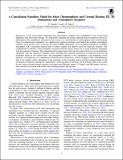Files in this item
A cancellation nanoflare model for solar chromospheric and coronal heating. III. 3D simulations and atmospheric response
Item metadata
| dc.contributor.author | Syntelis, P. | |
| dc.contributor.author | Priest, E. R. | |
| dc.date.accessioned | 2020-03-20T13:30:01Z | |
| dc.date.available | 2020-03-20T13:30:01Z | |
| dc.date.issued | 2020-03-03 | |
| dc.identifier | 266968518 | |
| dc.identifier | a04adfd8-ec2f-4a33-88ad-26a7fe61d1d4 | |
| dc.identifier | 000519058200001 | |
| dc.identifier | 85083917825 | |
| dc.identifier.citation | Syntelis , P & Priest , E R 2020 , ' A cancellation nanoflare model for solar chromospheric and coronal heating. III. 3D simulations and atmospheric response ' , Astrophysical Journal , vol. 891 , no. 1 , 52 . https://doi.org/10.3847/1538-4357/ab6ffc | en |
| dc.identifier.issn | 0004-637X | |
| dc.identifier.other | ORCID: /0000-0003-3621-6690/work/74117709 | |
| dc.identifier.other | ORCID: /0000-0002-6377-0243/work/77131781 | |
| dc.identifier.uri | https://hdl.handle.net/10023/19686 | |
| dc.description | This research has made use of NASA's Astrophysics Data System. This work was supported by computational time granted from the Greek Research and Technology Network (GRNET) in the National HPC facility ARIS. P.S. acknowledges support by the ERC synergy grant "The Whole Sun." | en |
| dc.description.abstract | Inspired by recent observations suggesting that photospheric magnetic flux cancellation occurs much more frequently than previously thought, we analytically estimated the energy released from reconnection driven by photospheric flux cancellation, and propose that it can act as a mechanism for chromospheric and coronal heating. Using two-dimensional simulations we validated the analytical estimates and studied the resulting atmospheric response. In the present work, we set up 3D resistive MHD simulations of two canceling polarities in a stratified atmosphere with a horizontal external field to further validate and improve upon the analytical estimates. The computational evaluation of the parameters associated with the energy release are in good qualitative agreement with the analytical estimates. The computational Poynting energy flux into the current sheet is in good qualitative agreement with the analytical estimates, after correcting the analytical expression to better account for the horizontal extent of the current sheet. The atmospheric response to the cancellation is the formation of hot ejections, cool ejections, or a combination of both hot and cool ejections, which can appear with a time difference and/or be spatially offset, depending on the properties of the canceling region and the resulting height of the reconnection. Therefore, during the cancellation, a wide spectrum of ejections can be formed, which can account for the variety of multi-thermal ejections associated with Ellerman bombs, UV bursts, and IRIS bombs, and also other ejections associated with small-scale canceling regions and spicules. | |
| dc.format.extent | 13 | |
| dc.format.extent | 2419799 | |
| dc.language.iso | eng | |
| dc.relation.ispartof | Astrophysical Journal | en |
| dc.subject | Solar coronal heating | en |
| dc.subject | Magnetohydrodynamics | en |
| dc.subject | Solar magnetic reconnection | en |
| dc.subject | Solar activity | en |
| dc.subject | Magnetic fields | en |
| dc.subject | Magnetohydrodynamical simulations | en |
| dc.subject | Solar coronal transients | en |
| dc.subject | QB Astronomy | en |
| dc.subject | QA Mathematics | en |
| dc.subject | T-NDAS | en |
| dc.subject.lcc | QB | en |
| dc.subject.lcc | QA | en |
| dc.title | A cancellation nanoflare model for solar chromospheric and coronal heating. III. 3D simulations and atmospheric response | en |
| dc.type | Journal article | en |
| dc.contributor.institution | University of St Andrews. Applied Mathematics | en |
| dc.identifier.doi | https://doi.org/10.3847/1538-4357/ab6ffc | |
| dc.description.status | Peer reviewed | en |
This item appears in the following Collection(s)
Items in the St Andrews Research Repository are protected by copyright, with all rights reserved, unless otherwise indicated.

